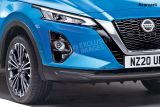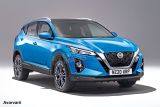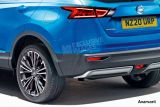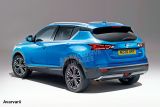A
Auto Express
Guest
This is our first look at the third-generation Nissan Qashqai SUV, spied in the hands of Nissan engineers ahead of its full debut towards the end of 2020.
It’s a hugely important car for the British motor industry. Not only is the Qashqai one of the most popular crossovers on sale in the UK, it’s also the most mass produced car in Britain, with Nissan’s Sunderland plant producing 257,851 examples in 2019. This all-new version will be built there too, as part of a £400m investment in the plant revealed by Nissan in March.
• Best crossovers currently on sale
The car in these first spy shots is a late development mule wearing near production bodywork under heavy camouflage. It’s difficult to make out fine details, but the exterior redesign is likely to echo that of the next X-Trail - leaked earlier this year in a series of patent images.
As is the current trend, expect the headlights to become slimmer, with the grille to grow in size, while the Qashqai will likely embrace a sportier image, hinted at by the IMQ concept car revealed at the Geneva motor show in 2019.
When it goes on sale hybrid power will be a part of the package for the first time in a Qashqai thanks to an updated version of the current car’s CMF underpinnings. Nissan is also considering ditching the Qashqai’s diesel engine to help lower the SUV’s carbon emissions

2020 Nissan Qashqai - front detail (watermarked)

2020 Nissan Qashqai - front (watermarked)

2020 Nissan Qashqai - rear detail (watermarked)

2020 Nissan Qashqai - rear (watermarked)

image

image

image

image

image

image
Nissan has also confirmed that there won’t be a pure-electric version of the new Qashqai. Full electric power will be reserved for a seperate SUV model based on an all-new platform, which is likely to underpin a whole family of electric cars spanning the B, C and D segments for Nissan and its Alliance partners Renault and Mitsubishi.
Speaking exclusively to Auto Express, Ponz Pandikuthira, Nissan’s European Vice President of Product Planning, said: “a new platform is what’s best to accommodate electrified technologies. It probably won’t include full electrification, because that’s a complete tear-up and the investment required for that would be considerably higher.”
Hybrid powertrains
As such, the new Qashqai could be offered with two hybrid powertrains – one featuring Nissan’s innovative ePower system and one sporting Mitsubishi’s plug-in hybrid powertrain. The former system is currently found in the Japanese-delivered Nissan Note, where it’s proven popular. It’s a series hybrid system featuring a petrol engine that works as a generator to charge the battery, which then powers an electric motor.
• Best hybrid cars on the market
“We’re investigating the ePower technology for Europe,” explained Pandikuthira. “The biggest difference when you do these onboard generator vehicles is highway driving – in Japan, they typically don’t go above 50-65mph.
“Here in Europe, you do 80-85mph on a regular basis. At those speeds, you end up depleting the battery very quickly, so the range extender has to work really hard to keep the energy going and then it goes out of its range of efficiency.”
However, Pandikuthira wasn’t convinced about the benefits of plug-in hybrids. He told us: “We’re not pursuing a big plug-in hybrid strategy. On some car lines we’ll try it out, but the business case for plug-in hybrids is not very good. For us, it’s a bridge technology for the next two to four years until battery costs drop to the point where the variable costs of making full EVs prevail.”
With two hybrid models planned for the next Qashqai, insiders have hinted that it’s likely to spell the end of diesel power in Nissan’s SUV. Sales of new diesel cars dropped by almost 32 percent in 2018 – and this trend continued into 2019, with new diesel vehicles declining in popularity by a further 28 percent.
Get the latest electric car news, reviews and analysis on DrivingElectric.com
Continue reading...
It’s a hugely important car for the British motor industry. Not only is the Qashqai one of the most popular crossovers on sale in the UK, it’s also the most mass produced car in Britain, with Nissan’s Sunderland plant producing 257,851 examples in 2019. This all-new version will be built there too, as part of a £400m investment in the plant revealed by Nissan in March.
• Best crossovers currently on sale
The car in these first spy shots is a late development mule wearing near production bodywork under heavy camouflage. It’s difficult to make out fine details, but the exterior redesign is likely to echo that of the next X-Trail - leaked earlier this year in a series of patent images.
As is the current trend, expect the headlights to become slimmer, with the grille to grow in size, while the Qashqai will likely embrace a sportier image, hinted at by the IMQ concept car revealed at the Geneva motor show in 2019.
When it goes on sale hybrid power will be a part of the package for the first time in a Qashqai thanks to an updated version of the current car’s CMF underpinnings. Nissan is also considering ditching the Qashqai’s diesel engine to help lower the SUV’s carbon emissions

2020 Nissan Qashqai - front detail (watermarked)

2020 Nissan Qashqai - front (watermarked)

2020 Nissan Qashqai - rear detail (watermarked)

2020 Nissan Qashqai - rear (watermarked)

image

image

image

image

image

image
Nissan has also confirmed that there won’t be a pure-electric version of the new Qashqai. Full electric power will be reserved for a seperate SUV model based on an all-new platform, which is likely to underpin a whole family of electric cars spanning the B, C and D segments for Nissan and its Alliance partners Renault and Mitsubishi.
Speaking exclusively to Auto Express, Ponz Pandikuthira, Nissan’s European Vice President of Product Planning, said: “a new platform is what’s best to accommodate electrified technologies. It probably won’t include full electrification, because that’s a complete tear-up and the investment required for that would be considerably higher.”
Hybrid powertrains
As such, the new Qashqai could be offered with two hybrid powertrains – one featuring Nissan’s innovative ePower system and one sporting Mitsubishi’s plug-in hybrid powertrain. The former system is currently found in the Japanese-delivered Nissan Note, where it’s proven popular. It’s a series hybrid system featuring a petrol engine that works as a generator to charge the battery, which then powers an electric motor.
• Best hybrid cars on the market
“We’re investigating the ePower technology for Europe,” explained Pandikuthira. “The biggest difference when you do these onboard generator vehicles is highway driving – in Japan, they typically don’t go above 50-65mph.
“Here in Europe, you do 80-85mph on a regular basis. At those speeds, you end up depleting the battery very quickly, so the range extender has to work really hard to keep the energy going and then it goes out of its range of efficiency.”
However, Pandikuthira wasn’t convinced about the benefits of plug-in hybrids. He told us: “We’re not pursuing a big plug-in hybrid strategy. On some car lines we’ll try it out, but the business case for plug-in hybrids is not very good. For us, it’s a bridge technology for the next two to four years until battery costs drop to the point where the variable costs of making full EVs prevail.”
With two hybrid models planned for the next Qashqai, insiders have hinted that it’s likely to spell the end of diesel power in Nissan’s SUV. Sales of new diesel cars dropped by almost 32 percent in 2018 – and this trend continued into 2019, with new diesel vehicles declining in popularity by a further 28 percent.
Get the latest electric car news, reviews and analysis on DrivingElectric.com
Continue reading...
